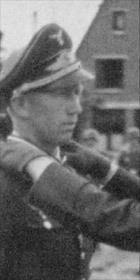Unit NJG 1 Role Pilot | Years of service 1939–43 Name August Geiger | |
 | ||
Buried at Ysselsteyn, Netherlands(Block M—row 4—grave 83) Battles/wars World War IIDefense of the Reich Battles and wars | ||
August Geiger (6 May 1920 – 29 September 1943) was a German Luftwaffe night fighter ace and recipient of the Knight's Cross of the Iron Cross with Oak Leaves during World War II. The Knight's Cross of the Iron Cross and its higher grade Oak Leaves was awarded to recognise extreme battlefield bravery or successful military leadership.
Contents
Career
Geiger was born on 6 May 1920 in Uberlingen, near Lake Constance. Geiger joined the Luftwaffe in late 1939 and was posted in mid-1941 as Leutnant to 8./Nachtjagdgeschwader 1 (NJG 1). Geiger's first two claims were a Vickers Wellington and a Armstrong Whitworth Whitley on 26 June 1942. By the start of 1943 Geiger had ten victories and been awarded the Iron Cross First Class.
In early 1943 Geiger was promoted to Oberleutnant (first lieutenant) and transferred to a 7./NJG 1, becoming Staffelkapitan (squadron leader) in May 1943, with some 40 confirmed victories.
On 29 September 1943 he was shot down by the Beaufighter VI of W/C Bob Braham of No. 141 Squadron RAF over the Zuiderzee, Netherlands. Gieger managed to bail out of his Messerschmitt Bf-110 G but was drowned when his parachute dragged him under.
He was posthumously awarded the Oak Leaves to his Knight's Cross on 2 March 1944.
In 328 combat missions, Geiger claimed 53 aerial victories, all of them at night. According to O.K.L. Fighter Claims Reich & Western Front 35 mm micro-films; Geiger and long time friend/fellow night fighter Herbert Lutje were reported to have shot down a Boeing B-17 Flying Fortress at 11:31 at 4,200 meters (13,800 feet) on 4 March 1943 during a daylight B-17 raid which was known by American pilots as the "Hamm Massacre".
